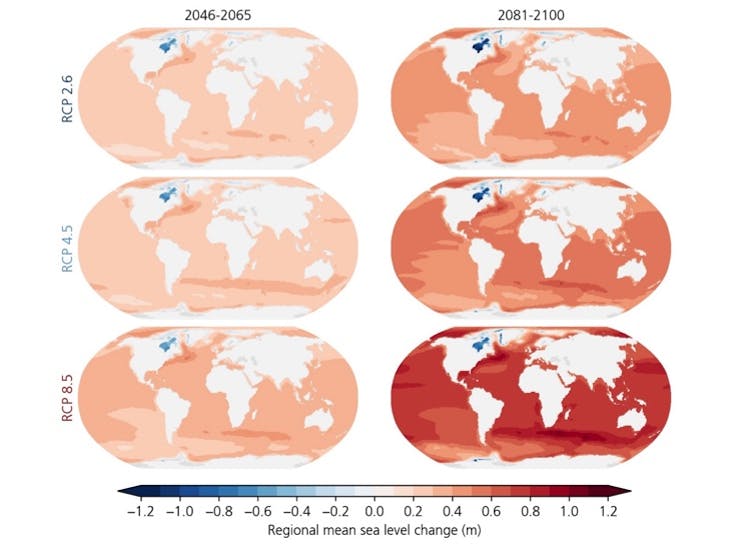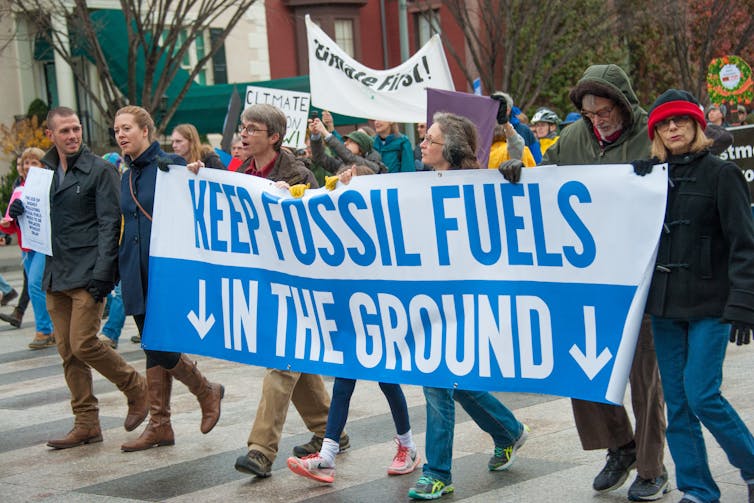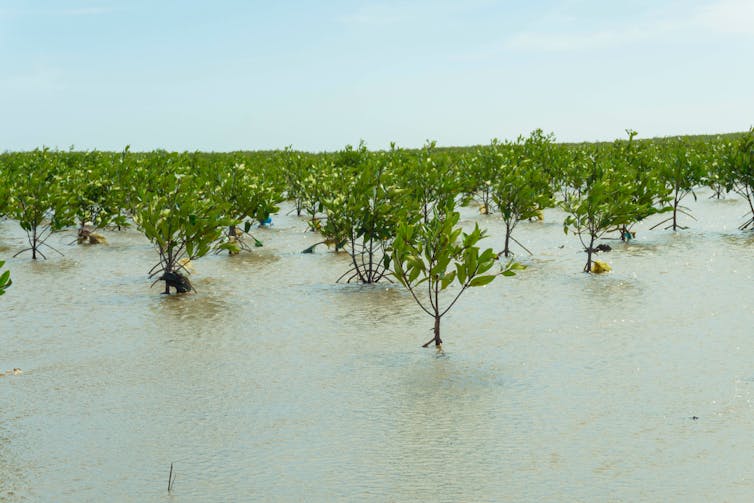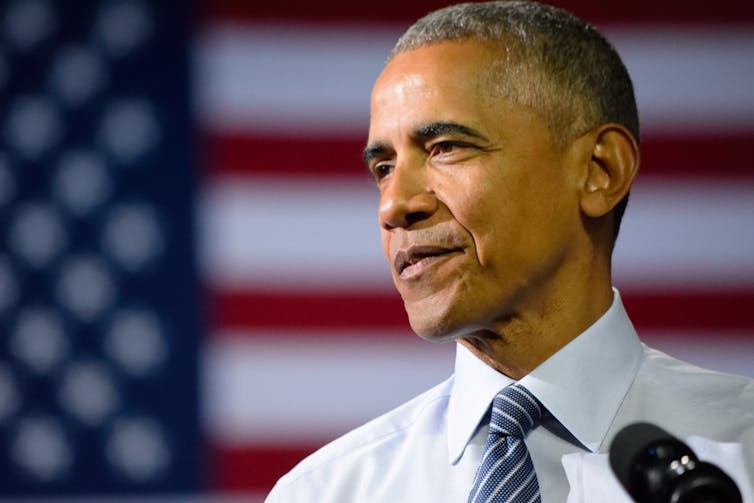Revolver Maps
среда, 30 октября 2019 г.
Climate crisis – here's what the experts recommend we do
Hannah Hoag, The Conversation and Jack Marley, The Conversation
The global strike on Friday September 20, 2019 was the largest demonstration for climate action in history. The movement that started with Swedish teenager Greta Thunberg in August 2018 has now mobilised millions, while Extinction Rebellion and other protest groups have escalated their campaigns on streets around the world. From the efforts of activists in different countries, radical “Green New Deals” are emerging as a bold, political response to the climate crisis.
“The world is waking up,” Thunberg told world leaders at the recent UN Climate Action Summit. “And change is coming whether you like it or not.”
But how long that awakening takes could be decisive for warming this century. A report published ahead of the summit declared that the impacts of climate change are accelerating – global emissions of carbon dioxide (CO₂) grew by 20% between 2015 and 2019, while the average rate of sea level rise has increased to 5mm per year over roughly the same period.

Predicted sea level rise this century if warming reaches 2.6°C, 4.5°C or 8.5°C by 2100.
IPCC, Author provided
One author warned that limiting global temperature rise to 2°C would require tripling current commitments to reduce emissions. To hold temperatures at 1.5°C above pre-industrial levels, global ambition would need to increase by a factor of five.
The debate over whether climate change is happening is over, and the conversation about what should be done is beginning in earnest. As such, for the past few weeks, we’ve asked experts from around the world to describe how the world should respond to the threat of climate breakdown. We share their insights here.
The state of the Earth
Nowhere are the effects of climate change more visible than in the Arctic – a region that’s estimated to be warming at least twice as fast as the global average. Arctic sea ice reached its second-lowest extent on record in September 2019 – a mere 1.6m square miles.
A new report by the Intergovernmental Panel on Climate Change (IPCC) has revealed the changes that are underway in the oceans and the ice-covered regions of the world, and the message is stark.
“Glaciers and ice sheets are shrinking. Global sea level is rising at more than twice the rate of the 20th century. The ocean is warming, becoming more acidic and losing oxygen. Fifty percent of coastal wetlands have been lost over the past 100 years. Species are shifting, biodiversity is declining and ecosystems are losing their integrity and function.”
– Cassandra Brooks, University of Colorado Boulder
Earth’s oceans have absorbed more than 90% of the excess heat in the global climate system, but not without repercussions. Marine heatwaves are causing coral reefs to bleach and mass die-offs of fish and other wildlife. Not only does this added ocean heat wreak havoc on marine ecosystems, but it is changing the relationship between coastal communities and the ocean.

Everywhere is warming, but the Arctic is warming fastest.
The Conversation/HadCRUT v4
Wildlife populations are struggling to adapt to the disruption, both in the oceans and on land. As a result, a landmark report from an international team of biodiversity experts earlier in 2019 called for “transformative change” to economies and societies to prevent up to a million species going extinct.
Five steps to restrain emissions right now
“The UK, Norway, Sweden and France have written a target of net-zero emissions into law, [but] targets are, by definition, a statement of nothing more than intent. In and of themselves, they do not remove a single molecule of carbon dioxide from the atmosphere.”
– Rebecca Willis, Lancaster University
Limiting global temperature rise to 1.5°C means the world has to be at net-zero carbon emissions by 2050. But it’s cumulative emissions that count – if countries leave decarbonisation until the last minute, it will be too late. Rebecca Willis, a professor of climate and energy policy at Lancaster University in the UK, outlines five measures that can begin to restrain emissions right now:

Protesters demand an end to fossil fuel exploration.
Rena Schild/Shutterstock
Think about natural climate solutions
There are technologies that already exist which are very good at capturing CO₂. Plants have perfected the process of turning carbon in the air into solid, living material over billions of years. Natural climate solutions mobilise this potential by restoring forests, wetlands and other habitats. One estimate from the UK suggests each hectare of new forest can absorb the annual carbon emissions of 90 cars.
But it’s not as simple as letting nature do all the hard work, says Sebastian Leuzinger, an associate professor at the Auckland University of Technology. The “right tree should be planted at the right time in the right place”:
Natural climate solutions can also help society adapt to the inevitable changes ahead. Zita Sebesvari, head of environmental vulnerability and ecosystem services at United Nations University, argues that the value of rewilding here is two-fold: removing the CO₂ that exacerbates climate change while mitigating its impacts.
Coastal wetlands, marshes and mangrove swamps can retain sediments and can grow vertically at rates equal to or greater than the mean rate of sea level rise. These habitats can also accumulate carbon 40 times quicker per hectare than tropical forests.

Replanting mangroves could protect tropical coastlines from flooding and storm surges, while absorbing atmospheric carbon and slowing climate change at the same time.
Janine Kandel/UNU-EHS, Author provided
How to feed the planet
Leaving room for nature seems radical when humans currently exploit more than 70% of the Earth’s ice-free surface, much of it to grow food. It’s estimated that a third of all greenhouse gas emissions originate with agriculture – from deforesting farmland to raising livestock that belch methane.
Farming for meat and dairy can use up to 100 times the land area to produce a single gram of protein compared to beans, nuts and other plant sources. Little wonder that people are encouraged to eat less of it, and Alessandro Demaio, a fellow in global health at the University of Copenhagen, recommends a “planetary health diet” which involves reducing meat intake in Western countries by 50%. He also calls for:
Sean Beer, a lecturer in agriculture at Bournemouth University, argues that eating more local and seasonal produce could go some way to decarbonising agriculture.
Reviving traditional food supply systems may also be key to guaranteeing sustainable diets for all, says Jagannath Adhikari, a sessional lecturer at the University of New South Wales.
More than 820m people suffer from hunger, and about two billion people face moderate food insecurity – meaning they do not always know when their next meal will come. After a decade of slow decline, climate change is driving this number up again, particularly in Africa and Asia, where competition over land for both farming and forest conservation is acute.
In parts of the Himalayas, the answer to this problem is “food forests”. Local people plant useful trees and grow crops in the woodland near their homes, and protect what grows there naturally. They harvest what they need – mushrooms, honey, roots and edible plants – and sell any surplus at a market. Since community rights were restored to forest management here, worrying trends in deforestation and poverty have been reversed.

A woman sells bamboo shoots in Pokhara, Nepal. These bamboo shoots are collected in forests at high altitude, 2,200-2,600 metres above sea level.
Jagannath Adhikari
Climate action means transforming the economy
Some politicians are now supporting policies that address climate change by transforming national economies under the umbrella of a Green New Deal. Spain’s socialist party was recently reelected on a Green New Deal platform, for example, and, in the UK, the Labour Party has voted in favour of one.
The idea was born in the UK in 2007, but has been gaining ground around the world lately, especially in the US where it has been championed by congresswoman Alexandria Ocasio-Cortez. Although the specifics vary, a Green New Deal involves large investments in clean energy sector jobs and infrastructure to decarbonise the economy and correct inequalities through job guarantees and universal basic services such as free public transport and healthcare. Governments would also be expected to slash or eliminate the billions they spend on subsidising the cost of fossil fuels.
Experts also urge for the inclusion of the insurance industry in Green New Deal discussions. A recent report from Cambridge University emphasised the large losses insurers will face under climate change and warns that it could spark a global financial crisis.
>“If governments respond appropriately to the urgent warning issued by the Intergovernmental Panel on Climate Change (IPCC) in October [2018], efforts to phase out fossil fuels will have to ramp up considerably — and quickly.”
– Kyla Tienhaara, Queen’s University, Canada
Already, there has been a slew of lawsuits against the largest fossil fuel companies in an effort to hold them accountable for misleading the public on the risks of climate change while selling products that have contributed to it. Litigation, thus far, has not been successful, but the tide may be turning.
In the US, more than a dozen cities, counties and states are seeking damages from energy companies for the the costs of climate change, from retrofitting storm drains to upgrading sea walls. These lawsuits draw on litigation against tobacco companies and on scientific research that attributes greenhouse gas emissions to energy companies.
In the past, “the plaintiffs had difficulties tracing climate harms to specific emissions made by particular corporations … Scientific research has evolved dramatically since then.” says Lisa Benjamin, from Lewis & Clark College of Law, in Portland, Oregon.
For example, in Europe, a German court has agreed to hear a Peruvian farmer’s case against the German energy giant RWE for its role in melting the glaciers near his hometown of Huaraz and raising the risks of landslides and flooding. A study found RWE was responsible for 0.47% of historic emissions, so the farmer is seeking 0.47% of the cost for his community to adapt to climate change.

Melting glaciers threaten the village of Huaraz, Peru.
Uwebart/Wikimedia, CC BY-SA
As the impacts of climate change become more clear, Thunberg’s not the only one questioning the “fairy tales of eternal economic growth”. Producing stuff consumes energy, and producing more stuff, whether it’s fast fashion or smartphones, means the ongoing and growing consumption of energy.
“This makes it very hard to decarbonise the economy,” says Simon Mair at the University of Surrey. If we stopped chasing productivity growth, decarbonisation would come easier, we’d have less “crap” and we might start investing time and human energy into good jobs that matter, like teaching and nursing.
The media is finally listening to the experts
Despite the potentially massive implications of a 2°C rise in global temperature, climate change has remained low on the news agenda. Journalists and their news organisations have largely failed to give climate change the attention it deserves and have failed to press political figures on climate issues and policies.
Years ago, climate journalists threw away the notion of putting scientific fact and climate denier opinion on equal ground. Other media are finally catching up and providing analysis and verification, and improving the scientific literacy of their audience. They are connecting climate change to local stories, focusing on solutions (instead of “doom and gloom” coverage) and adjusting their language to describe the “climate crisis”.
These shifts in journalism may yield more action on climate change. Young people tend to avoid negative news headlines; they don’t want their climate coverage to present a bleak and certain future. Instead, they want stories about the “system change” necessary to create zero-carbon societies, says Julie Doyle, from the University of Brighton. It’s not that they can’t handle the bad news, but that “they wanted to be involved in rethinking socioeconomic systems, and are inspired and empowered by working together.”
That’s why “system change not climate change” has became the rallying cry of the young climate strikers. Thunberg’s journey from a lonely vigil outside the Swedish parliament to a Nobel Peace Prize nominee at the head of a global movement took just over a year. It seems the world really is waking up, but now comes the hard part – changing the systems that fuel the climate crisis before it’s too late.

Click here to subscribe to our climate action newsletter. Climate change is inevitable. Our response to it isn’t.
Hannah Hoag, Deputy Editor and Environment + Energy Editor, The Conversation and Jack Marley, Commissioning Editor, The Conversation
This article is republished from The Conversation under a Creative Commons license. Read the original article.
пятница, 25 октября 2019 г.
Donald Trump's war on facts is the latest play in a long-established tradition to create a post-truth reality
Sverre Spoelstra, Lund University
This is the “post-truth age”. Over the past few years, politicians from Europe to South America and the US, have been labelled “post-truth leaders”, with US president Donald Trump becoming the standard bearer for this strange new world.
But post-truth leadership is nothing new. Ever since sociologist and political economist Max Weber developed his notion of charismatic leadership in the early 20th century, many societies have been infatuated with the idea that leaders ought not to concern themselves too much with factual reality. In fact, leadership has long been “post-truth”, a topic I explore in my recent book.
According to Weber (1864-1920), “charismatic leadership” is a form of authority that derives from the attribution of extraordinary qualities to an individual by his (rarely her) followers, qualities that, in a quite literal sense, do not belong to the normal order. This distinguishes charismatic leadership from the authority of law or tradition, which are ordinary forms of domination that do not rely on an exceptional human individual.
The religious origins of the notion of charisma (from the Greek χάρισμα, meaning “gift of grace”) are not coincidental. Weber elevates the charismatic leader to a sphere that is uncontaminated by the reality and constraints of ordinary life. Weber’s charismatic leader is essentially transgressive, one who oversteps the bounds of the present order and whose supporters take these transgressions as proof of their leader’s extraordinary character.
The ‘wimp factor’
Such otherworldly expectations can be difficult for leaders to live up to. Prior to his election, former US president George H W Bush was criticised for a lack of “vision”. Indeed, rather than embracing the idea of becoming a charismatic leader, Bush responded with open contempt for “the vision thing”. Newsweek magazine later spun this comment into a famous cover story that framed a feeble Bush in terms of his battle with the “wimp factor”“. This image of a weak leader lacking in vision was to haunt Bush throughout the single term of his presidency.
Read more:
The surprising origins of 'post-truth' – and how it was spawned by the liberal left
The expectation that "real” leaders must have a compelling vision is important for understanding the relationship between leadership and truth. A vision may be seen as a “higher truth” by the leader’s supporters or, alternatively, as a “great lie” by their opponents.
Either way, visions have little to do with facts. A factual statement talks about the actual, about the things that are in the present, or have happened in the past. But the image of the visionary or charismatic leader is of someone who thinks and speaks in grand terms about the future.
Such future-oriented speech cannot be fact-checked because it belongs to the domain of the potential, the as-yet-unrealised world of what might yet come to be. Martin Luther King’s “I Have a Dream” speech, for instance, conveys a vision that has come to be seen as a great truth, but it is not, itself, a true or false statement. It is a vision – albeit one of inspiring justice and hope.
More contentious visionary claims, such as Trump’s promise to “Make America great again”, are similarly immune to falsification.
Indeed, it is unsurprising that politicians who want to be perceived as “great” leaders will often avoid statements that can be fact-checked as they focus instead on captivating their audiences with visions of the world to come.
By avoiding the realm of the factual, leaders can demonstrate that their minds are not shaped by the past or the present. Rather, they already – in a sense – inhabit a glorious future and show the rest of us how we can join them. It is a future where Ronald Reagan’s “Shining City Upon A Hill” will become ever brighter, but will likely also remain ever elusive, a promise that need never be kept.
And so Trump, as the New York Times wryly observed, is “trying to create an atmosphere in which reality is irrelevant”. For Weber, this is part and parcel of the nature of charismatic leadership: by demonstrating a lack of interest in the past and the present, charismatic leaders create the image that they belong to a higher sphere in order to bring about future change.
So what’s new?
While leadership has been a post-truth pursuit for a long time, dating back to well before Weber, there is something strange and new about contemporary post-truth leaders such as Trump. In contrast to Weber’s charismatic leader, who does not concern himself with the factual, Trump and his administration do speak, very frequently, in the language of facts. Of course, these aren’t really facts based in reality, but rather “alternative facts” spun out of a parallel, often fictional, version of how things are.
Indeed, this is something that has fuelled the rise of fact-checking media. Uncovering the falsehoods of a leader like Trump, who has at least 12,000 to his name according to The Washington Post, is unquestionably a vital task for the preservation of a healthy democracy. But it is equally important to ask what it is he achieves by saying things that are demonstrably false.
The reason why few commentators have asked this question may be because the answer seems to be too obvious to warrant much consideration: by lying about the facts, Trump and other post-truth leaders aim to deceive people into thinking more highly of them and their policies than they deserve. There is, no doubt, some truth to this, but it is not the full story.
Read more:
Fake news: emotions and experiences, not more data, could be the antidote
Trump’s lies are as much a demonstration of power as they are statements that intend to deceive. Trump’s infamous campaign promise to “lock up” Hillary Clinton if elected was hardly meant to be believed – it was primarily an attempt to create an image of himself as someone whose power stands above the law.

Obama: a bigger inauguration than Trump. In the real world, at least.
Shutterstock
Even the lies that do aim to deceive their audiences, perhaps most famously Trump’s demonstrably false claim that his inauguration attracted a larger audience than that of his predecessor Barack Obama, also show to his constituency that he has no need to conform to the norms according to which ordinary people must abide. In this sense, he is still a characteristic example of the transgressive Weberian leader.
What is new in post-truth leadership is not its disinterest in reality, but the way in which it demonstrates its otherworldliness: not by avoiding factual statements, but by showing contempt for their importance. This combative approach to facts may be new but its effect is very much in line with traditional charismatic leadership. For, in demonstrating his otherworldliness, a figure like Trump also creates a faith-based world in which he can define what is true.
The present effort to impeach Trump is not merely a power struggle between the Democrats and the Republicans, and nor is it merely a question of the powers of bureaucracy versus a “rogue” leader. The issue is both broader and deeper: it is a test on a grand scale of how deeply ingrained the Weberian notion of leadership is in the Western world.
Sverre Spoelstra, Associate professor, Lund University
This article is republished from The Conversation under a Creative Commons license. Read the original article.
пятница, 11 октября 2019 г.
Маат: древнеегипетская богиня правды, справедливости и нравственности
Маат, также известная как Ма'ат или
Майет, была богиней-женщиной в древнеегипетской религии, которая представляла
истину, справедливость, равновесие и мораль.
Дочь египетского солнечного божества Ра
и жена лунного бога Тота, она служила своего рода духом справедливости
египтянам. Она решала, может ли человек успешно достичь загробной жизни, сравнив
его душу на весах с пером истины, олицетворяла космический порядок
и символизировала стабильность вселенной. Самые ранние писания, в которых она
упоминается, относятся к Древнему царству более 2300 лет назад.
Поддерживая порядок на небе и земле
Стержнем египетской культуры был
порядок, все занимало свое место в мире. Это включало религию, общество и
сезонные изменения. Богиня Маат являлась олицетворением баланса и порядка,
потому что многим египтянам нужно было объяснить мир вокруг них. Именно она
поддерживала движение звезд, смену времен года и порядок на Небесах и Земле.
Противодействующая этому сила была
известна в древних терминах как «исфет» или хаос. Древние египтяне считали
пустыню за рекой Нил хаотичной; в то время как область, близкая к Нилу,
считалась упорядоченной. Вместе эти две силы приносили равновесие в мир, в
котором они жили, и были важной частью повседневной египетской жизни.
Древняя
картина египетского бога Ра и Маат со страусиным пером в головном уборе (Stig Alenas / Adobe Stock)
Изображения Маат
Настенный рельеф Маат
в восточной части храма Эдфу, Египет. Страусиное перо видно на макушке. ( Wikimedia Commons )
Маат обычно изображали в виде женщины,
сидящей или стоящей с распростертыми крыльями на обеих руках. Иногда в одной руке она держит скипетр, а в другой - анкх (символ жизни).
.
Ее статуя обычно располагалась на каменной
платформе, являвшейся прочным фундаментом. Общий символ, связанный с ней, - это страусиное
перо, которое почти всегда изображено в её волосах. Часто перо Маат было
отличительной чертой ее головного убора.
Реже её изображали без головы, вместо
которой было изображено перо. На других изображениях одно только перо передавало
ее присутствие. Это перо и стало символом ее бытия, а также символом баланса и
порядка, в дальнейшем оно стало иероглифом понятия «истина».
Маат как руководитель правосудия
Маат в древнем Египте ассоциировалась с
законом. Начиная с 5-й династии (ок. 2510-2370 гг. до н.э.) визирь,
ответственный за судебную систему, являлся жрецом Маат, и в более поздние
периоды судьи носили ее изображения. Воплощением «Духа Маата» был главный судья,
отвечающий за египетские суды. У него была двойная роль: он служил священником
и работал непосредственно в судах и системе правосудия. «Священник Маат» начиная
судебные слушания, надевал перо Маата, и другие придворные чиновники носили
маленькие золотые изображения богини как знак своей судебной власти, а также
как символ того, что их решение будет сбалансированным и справедливым.
Священники рисовали зеленой краской на
своих языках Перо Маат, чтобы слова, которые они произносили, были правдой.
Священник должен управлять земным наказанием в соответствии с природой
нарушенного закона. Наказания включали штрафы, телесные наказания и в крайних
случаях смертную казнь. Преступлениями против Маат считались ревность,
нечестность, обжорство, лень, несправедливость и неблагодарность.
Считалось, что виновный египтянин
нарушил Дух Маат и подвергнется дальнейшему суду в Подземном мире во время
церемонии оправдания в Зале Двух Истин. «Дух Маат», описанный в литературе
мудрости, содержал практическое руководство с примерами и некоторыми правилами,
применявшимися в предыдущих судебных делах. Эти учебные тексты являлись
«литературой Маат».
Выдержка из «Книги
мертвых», написанной на папирусе и показывающей «Взвешивание сердца» с
использованием пера Маат в качестве меры противовеса. Создано неизвестным
художником
Суд мертвых
«Книга
мертвых» - это коллекция погребальных текстов и заклинаний древнего Египта,
призванная помочь человеку путешествовать по подземному миру и загробной жизни.
Считалось, что без этих заклинаний человек не сможет действовать. В книге
главным является заклинание «Сорок два заявления о чистоте». Это заклинание
состоит из признаний, которые, как полагал владелец гробницы, он совершал всю
свою жизнь. Считалось, что любые преступления, совершенные против Маата, должны
быть записаны.
В Зале Маат проходил суд над мертвыми, в
котором Маат играла важную роль. Церемония под названием «Суд Осириса» была
названа в честь Осириса, бога мертвых. На весах взвешивали сердце умершего, на
другой чаше весов располагалось перо Маат. Если устанавливалось равновесие
умерший считался достойным встретить Осириса в раю. Невесомость их сердец указывала
на то, что их души не были обременены грехами и злом. Если сердце умершего оказывалось
тяжелее, чем перо Маат, оно отдавалось на съедение Аммиту - поедающему душу
монстру, которого изображали с головой крокодила, передней частью льва и
задней частью бегемота , В зале суда были и другие боги, которые являлись
частью трибунала, следящего за взвешиванием сердца. Их также изображали с
пером, но весы всегда представляли Маат.
Египетская богиня Маат
(rysp / Adobe Stock)
Разумно предположить, что ее принципы
помогли народу Египта стать лучше, и что ее можно сравнить с совестью человека.
В Карнакском храмовом комплексе в
Луксорском Египте был небольшой храм, посвященный Маат Хатшепсут, пятому
фараону восемнадцатой династии Египта, первой египетской женщине-фараону. В
основном в руинах, он все еще сохраняет надписи некоторых визирей Рамсеса III и
XI. В этом районе существовал предыдущий храм Маат, о чем свидетельствуют
рельефы и стелы, принадлежавшие царствованию Аменхотепа III. Храм находится в
районе Монту, в самом маленьком из трех корпусов в Ипет-Исут.
Вы можете ознакомиться с тем как вам пришлось бы отчитываться перед Маат - 42 заповеди богини Маат.
10 из них потом стали заповедями Моисея.
вторник, 8 октября 2019 г.
Куб суммы чисел показывает исходные числа
1212 + 1388 + 2349 = 4949; 49493 = 121213882349
1287 + 1113 + 2649 = 5049; 50493 = 128711132649
1623 + 2457 + 1375 = 5455; 54553 = 162324571375
1713 + 2377 + 1464 = 5554; 55543 = 171323771464
3689 + 1035 + 2448 = 7172; 71723 = 368910352448
1287 + 1113 + 2649 = 5049; 50493 = 128711132649
1623 + 2457 + 1375 = 5455; 54553 = 162324571375
1713 + 2377 + 1464 = 5554; 55543 = 171323771464
3689 + 1035 + 2448 = 7172; 71723 = 368910352448
Подписаться на:
Комментарии (Atom)






